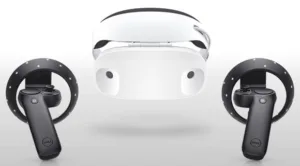Dell Inc. presented a Windows 10-based mixed reality headset earlier this month at the IFA conference in Berlin. The company stated that the headset was designed not only to provide the user with an immersive VR experience but to do so in a way that is physically comfortable for the user.
The Dell Visor includes a pair of 2.89″ Sharp LCDs each having a resolution of 1440 x 1440 (that is, 706ppi) and operating at a refresh rate of 90 Hz. The Fresnel-based optical system provides a 110º field of view. The system software can be used to adjust the inter-pupillary distance to suit the user.
The visor part of the headset can flip-up, raising to an angle of 90º to the headband. This feature is intended to allow the user to rapidly transition between the virtual and real world environments. The visor is designed to fit comfortably over eyeglasses.
Sponges are included in the front and rear parts of the headband. They are made from a high density material and serve to reduce friction and enhance comfort. The front sponge is attached with Velcro thus allowing it to be swapped out to best fit the size of the user’s head. An adjustable thumbwheel lets the user further adjust the size of the headband to suit size of their head. Since the headset is supported by the headband, the visor sits lightly on the user’s face. This, in turn, means that the bridge of the user’s nose takes less pressure allowing the headset to be worn for an extended period of time without causing user discomfort. In addition, since the visor is not in direct close contact with the user’s face, the user’s eyes and face are “allowed to breathe.” A rubber nose pad mostly blocks ambient light.
In sum, the Dell Visor was designed with the expectation that the user will wear it for an extended period of time. Although the headset has the capability to browse the internet, it is not intended to compete with a desktop computer display but, rather, to be an alternative to watching television on a large screen.
Dual black and white VGA cameras are positioned on the front of the headset. These are used for six degree of freedom “inside-out” tracking of hand held controllers without the need for external sensors. Also in the visor are a gyroscope, an accelerometer and a magnetometer. Collectively, these sensors enable effective physical movement by the user in the virtual reality environment. It might be mentioned that the capabilities of the Dell Visor Controllers are similar to those of the more familiar Oculus Rift Touch Controller.
The Dell Visor model VR118 and the Dell Visor Controllers model VRC100.
Several minor aspects of the headset include the following.
- A cable management clip on the headband secures and routes the Y-cable, a cord that splits in two and connects the USB 3.0 for power and HDMI for video, to below the headband and out of the user’s line of sight.
- Headphones are not supplied with the headset.
- The headset includes an anti-stain coating to help it stay clean.
A video illustrating and discussing the Dell Visor headset can be found at the end of this article.
The Dell Visor is planned to go on sale during mid-October with a starting price of $349 for the headset (the headset needs the Creators Edition of Windows 10, which will be released on October 17th – Man. Ed.). The controllers will be sold separately at a retail price of about $100. -Arthur Berman

